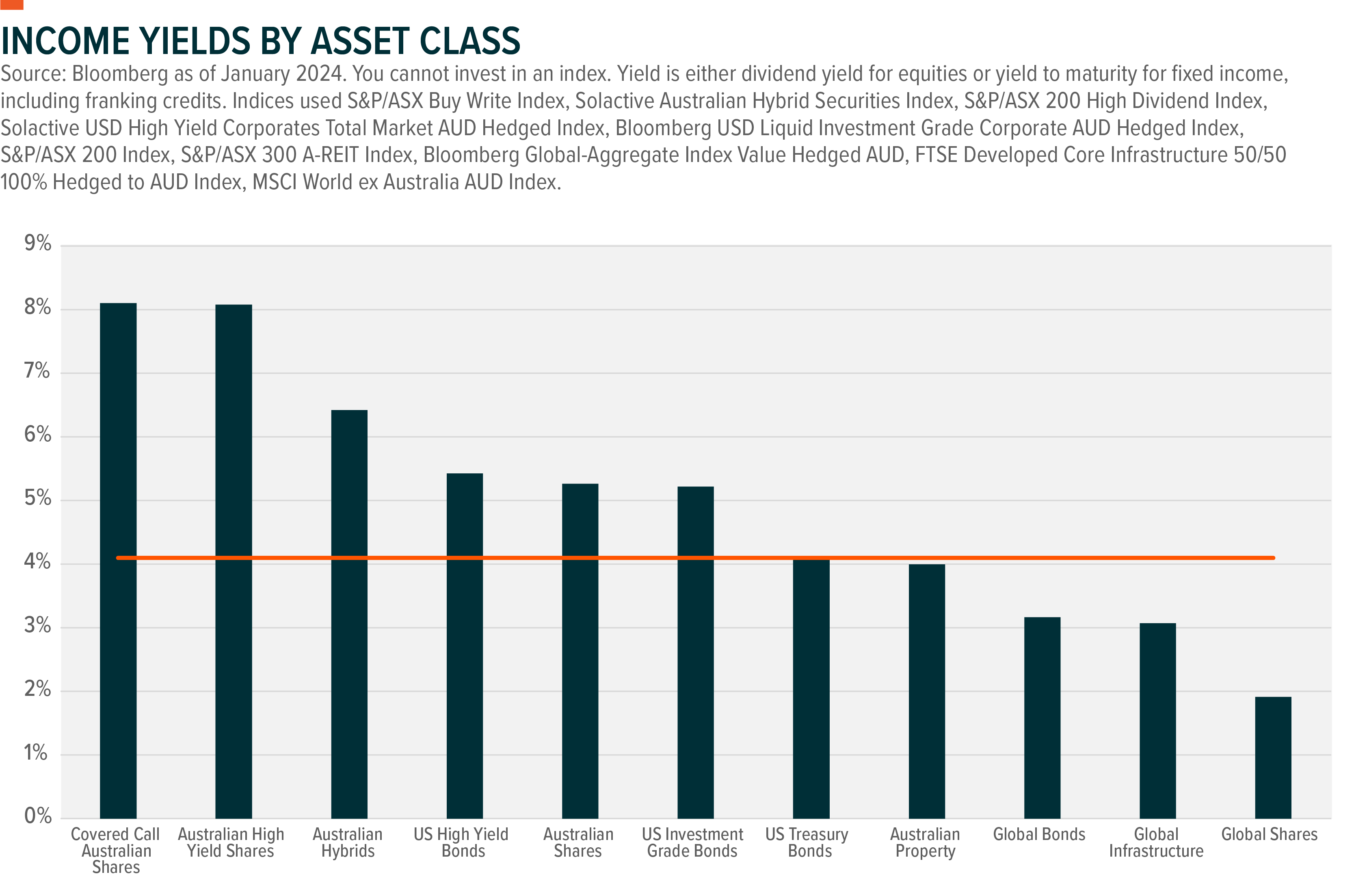How to earn sustainable income using ETFs and LICs (plus 8 ideas for your watchlist)
The sluggishness of the economy, compounded by rising interest rates and slow disinflation, means the risk investors need to take to earn regular income from an investment portfolio can vary greatly. Right now, it feels like the tide is high and investors can earn juicy yields without taking excessive risk.
Many of the financial advisers I speak with say they are ‘picking the eyes’ out of fixed interest markets because they can get equity-like returns without taking on the extra risk. At the same time, we’re seeing more options for investors to access these asset classes hitting the ASX.
Of course, it won’t always be like this and you only need to think back a few years to a time when term deposits were near worthless and everyone was forced into riskier asset classes.
As part of Livewire’s Listed Series for 2024, I hosted a panel featuring Marc Jocum from Global X ETFs and James Diegelman from TMS Capital designed to help investors take advantage of the current environment to set up a portfolio that can deliver sustainable income.
My guests share their assessment of the environment for income, offer some useful portfolio construction tips and name their go-to ETFs, LICs and LITs for generating income.

Why investors are hunting extra income?
Returns of traditional income assets such as term deposits and bonds have improved due to the recent rises in official interest rates. But inflation has also picked up and this is having an impact on real wages, which is effectively wage growth minus inflation.
Wages growth hasn’t kept pace with inflation and that means the average person's purchasing power is going backwards. The chart below shows the decline in real wages is at multi-decade lows. Naturally, people are looking to supplement their wages with additional income that can be earned through investing.
“If you look at the ASX investor study as an example which showed that the most important consideration for investors was creating and building a sustainable income stream,” says Marc Jocum from Global X ETFs.

Which asset classes should you include in an income portfolio?
With defensive investments like bonds offering high yields, it is tempting to stack a portfolio with these types of assets. However, the decline in purchasing power illustrated above also relates to fixed interest investments where the principal is returned to investors when the instrument matures. James Diegelman from TMS Capital says this important detail is often overlooked or misunderstood by investors.
“If you were to put $100,000 into a Westpac bond paying that 7.2% in 10 years when it matures, you are going to lose 30 - 35% of your purchasing power. So you can’t just build a portfolio and put all of your money into fixed-interest,” explains Diegelman.
“It’s really important to build out an equity portfolio, paying income as well, but it is also a natural hedge against inflation,” he says.

Jocum also advocates diversifying across asset classes and believes taking a total return approach is the best way to build in that ‘reliable’ component to your portfolio.
“Don’t overlook the growth component of your portfolio as an income source. Whilst yields today look pretty good they might not always be so juicy. Having an allocation to growth assets gives you the flexibility to draw on these and add to your regular income.”
Jocum uses the slide below to show the breadth of opportunities available to investors. The chart shows the yields available across defensive and growth assets as well as highlighting strategies, such as Covered Calls, that can also provide extra income over an equity portfolio.

Jocum says including asset classes that are not correlated with each other can help to protect your capital value. One example he offers is having an allocation to gold, which seems odd given it doesn’t generate income. He explains that gold can offer ballast within a total portfolio and help investors to "stay the course."
So how should investors think about balancing asset classes?
That will depend on your circumstances and attitude towards risk, according to Diegelman. He says the starting point with his clients is addressing these three questions.
1) What is your risk tolerance?
“If your portfolio fell 15% but your income didn’t change, how would you feel? Would you be able to sleep at night, could you deal with that?”
2) What is your capacity to take on risk?
“If you’re young, you can keep putting money into the market and volatility is your friend. Once you’ve retired and you’ve got your set pool of capital volatility is not your friend.”
3) How much risk is required?
“Don’t risk money you already have for money you don’t need. If you only need a 6% return don’t chase double-digit returns”
The answers to these questions will then flow through to the asset class mix that is suitable for you. The table below offers a framework that Diegelman uses with his clients to help determine a suitable allocation.
Defensive (%) |
Growth (%) |
|
Conservative |
60 |
40 |
Moderate |
50 |
50 |
Balanced |
30 |
70 |
Growth |
20 |
80 |
High Growth |
5 |
95 |
8 ideas for your watchlist
I asked each of my guests to bring along an example of an ETF, LIC or LIT that they think can play a role in an income portfolio. The examples below are not recommendations and investors should still conduct their own research.
Marc Jocum’s four ETFs for an income portfolio
Marc nominated the following four ETFs for consideration in an income portfolio.
- Global X S&P/ASX 200 High Dividend ETF (ASX:ZYAU)
- Global X S&P/ASX 200 Covered Call ETF (ASX:AYLD)
- Global X US Treasury Bond (Currency Hedged) (ASX:USTB)
- Global X USD Corporate Bond ETF (Currency Hedged) (ASX:USIG)
James Diegelman’s picks for an income portfolio
James nominated the following four LITs/LIC for consideration in an income portfolio.
More from 2024 Listed Series

Learn how to choose the right exchange traded products for your goals, like growth or income, and build your perfect portfolio on the ASX.
- 4 tips and tricks every ASX ETF investor should know
- The best ASX ETFs to help protect and grow your portfolio
- Hunting for double-digit returns with lower levels of risk
- Why this US$77 billion investor is investing in more defence when others are chasing growth

4 topics
1 contributor mentioned


